Canon J-II Rangefinder Camera
A Description of this Model Produced During 1946
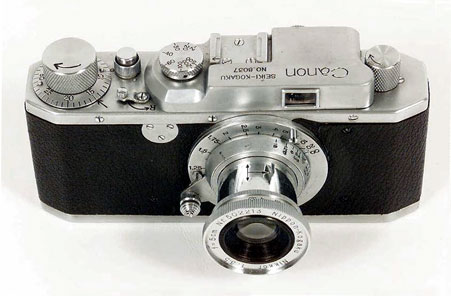
Canon J-II of 1946
Resumption of Seiki-Kōgaku Production with the Canon J-II in 1945
In late 1945, staff of the Seiki-Kōgaku Kogyo Co., Ltd. gradually returned to Tokyo and began to restore camera production. The Canon history site states that the main factories survived the war "without major damage". The Canon site further states:
"...the Allied Occupation Forces (centered on the U.S. Forces) showed great interest in Japanese cameras. [Dr. Takeshi] Mitarai felt that it was not impossible to restart camera production, and submitted an application for production of consumer goods to the GHQ (the Allied Army General Headquarters). The application was granted on October 1, l945, two months after the end of the war, for Precision Optical Industry Co., Ltd. to resume the production of cameras. 4 The primary producion was at the Canon factory near the Schimomaruku train station, Tokyo which was later expanded into the Canon headquarters complex. 4
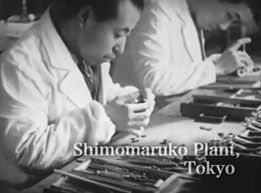
the Canon factory Schimomaruku where production was resumed in late 1945
At first, at the end of 1945, a simple camera was assembled from Canon S and Canon J parts. Like the Canon J, this simple model had no slow shutter speeds and no rangefinder assembly. This made it relatively easy to assemble without need for precision equipment, although apparently only three cameras were actually produced by year end 1945. 4
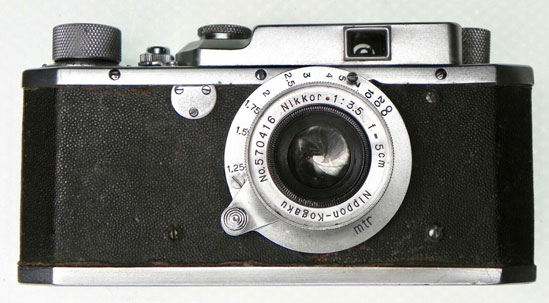
a Canon J-II serial number 8360
Canon J-II Characteristics
Since the Canon J-II had no slow shutter speed mechanism, the body hole for the slow shutter speed was either covered with a semi-circular plate, or, as in my model had the hole filled with solder. In the case of the semi-circular plate, the existing three screw holes in the body intended to secure the slow shutter speed assembly were used to bolt down the plate.

the hole plate cover on some Canon J-II bodies
The body also retained the small notch of the Canon S body just above and to the right of the lens flange opening. This notch was used for the rangefinder coupling pin to pass through the Canon S body. Although not needed for the Canon J-II with no rangefinder, these body parts were what was available for Canon J-II assembly. The body notch is often even more easily seen on many surviving Canon J-II models, since the material used for the leatherette-styled body covering was particularly flimsy, and often has easily fallen off.

the body notch of the Canon J-II
The Canon J-II Lens Mount
The Canon J-II lens mount was also that of the Canon S, which used 24 threads per inch. My example of the Canon J-II came with the collapsible Letana Anastigmat 50mm f3.5 lens which would fit this lens mount. The Letana Anastigmat 50mm f3.5 was intended for the Leotax Leica-style rangefinder camera developed by Showa Kōgaku Seiki K.K. and was produced at about the same time as the Canon J-II. Most Canon J-II models sold to occupation troups were sold with a Nikkor 5cm F3.5 lens, as is my J-II in the photograph above.
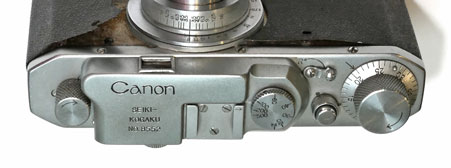
top of my Canon J-II showing detachment of the paper body cover typical of the early post-war poor materials
The superstructure of the Canon J-II containing the viewfinder was different from the Canon J, with the structure wrapping partially around the film rewind knob.
Canon J-II Production
The Canon history site states that only 560 Canon J-II cameras were produced during 1946, indicating the continuing difficulty in during a period of lack of raw materials and disrupted transportation. 4 These would have been sold primarily to American troups occupying Japan. During this year, Canon was working to re-establish quality production which was to lead to the introduction of the new Canon S-II in November 1946.
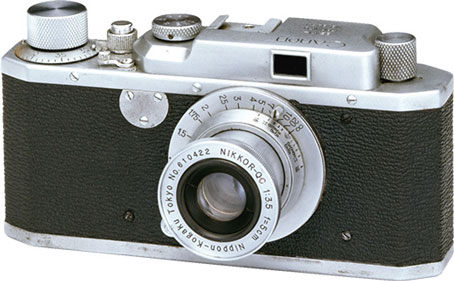
Canon J-II with the Nikkor 50mm f3.5 lens and metal plate covering the slow speed hole
You can click on the links in the table below to consult other pages of the canonrangfinder.org site.
| Navigation: Click Below to Jump to Desired Subject Page | ||
|---|---|---|
| Canon Rangefinder Cameras - 1 | Canon Rangefinder Cameras - 2 | Canon Rangefinder Lenses |
| Canon Hansa | Canon IIAF, IIAX | Development Nikkor 50mm |
| Canon S | Canon IVSB2 | Canon 19mm |
| Canon J | Canon IIS2, IID2, IIF2 | Canon 25mm |
| Canon NS | Canon VT, Canon L2 | Canon 28mm |
| Canon JS | Canon L1, L3 | Canon 35mm |
| Canon S-I | Canon VT Deluxe | Canon 50mm |
| Canon J-II | Canon VL, VL2 | Canon 85mm |
| Canon S-II | Canon VI-L, VI-T | Canon 100mm |
| Canon IIB | Canon P | Canon 135mm |
| Canon III, IIC, IV | Canon 7 | Canon 200mm-1000mm |
| Canon IIIA, IVF, IVS | Canon 7s | Canon Accessories |
| Canon IIA, IID, IID1 | Nicca Rangefinders | Canon Finders |
| Canon IVSB | Minolta Rangefinders | Minolta Lenses |
| Canon IIF, IIS | Other Rangefinders | other M39 lenses |
| Go to canonrangefinder.com home page | ||
Any additions or corrections to these pages would be welcome simply by contacting this site as shown at the foot of this page .
Footnotes:
1 Dechert, Peter. Canon Rangefinder Cameras 1933-1968. Hove Collectors Books. West Sussex, United Kingdom. 1985. ISBN 0-906447-30-5.
Peter Dechert's book is the most important expert source of information regarding Canon Rangefinder Cameras.
2 Kitchingman, Peter. Canon M39 Rangefinder Lenses 1939-1971. A Collector's Guide. Published by Peter Kitchingman. Perth, Australia. 2008. ISBN 978-0-646-48144-9.
Peter Kitchingman's book is the definitive study of the more than three decades of M39 format camera lenses developed for Canon Rangefinder Cameras.
3 Nostalgic Canon Camera Book. 懐かしいキヤノン EI Publishing Co. Ltd. Tokyo, Japan. June 2003.
Peter Kitchingman's book is the definitive study of the more than three decades of M39 format camera lenses developed for Canon Rangefinder Cameras.
4 "Canon Camera Museum" history website. https://global.canon/en/c-museum/history/ published by Canon, Inc. accessed in 2019.
5 Rajner, Hans P. (author), John Wade (editor). Leica Copies. Classic Collections Publications. London, UK. ISBN 13: 9781874485056
Hans P. Rajner's book is an excellently detailed and carefully researched study of camera from around the world which used the Leica M39 lens mount and the same lens to film plane distance.
7 Dechert, Peter. Canon Single Lens Reflex Cameras 1959-1991. Historical Camera Publications. Yakima, Washington. 1992. ISBN 1-879561-04-2.
8 Tomlinson, Shawn M. The Film Photography Book. Lulu Pulbications. 2016. ISBN: 9781365263972
9 Sartorius., Ghester. Identifying Leica Lenses. Classic Camera 19. Tokyo, Japan. 2001. ISBN 4-257-12029-0
10 website http://www.nicovandijk.net/rflensmatrix.htm consulted 2019.
11 O'Reagan, Douglas M. Allied Exploitation of German Science after World War II. Johns Hopkins University Press. Baltimore, Maryland. 2019. ISBN 9781421428888
12 website www.canonrangefinder.servehttp.com consulted 2008.
13 Minolta expert Andrea Aprà has posted information on minoltarangefinders group and other groups and further detailed information by email. (thanks Andrea !)
14 website http://www.collection-appareils.fr/objectifs/ consulted 2019.
15 Small, Marc James. Non-Leitz Leica Thread-Mount Lenses. Wittig Books. Hückelhoven, Germany. 1997. ISBN 3-930359-47-2.
16 the Nikon Corporation website: https://imaging.nikon.com/history/ consulted 2019.
17 p 152. Ray, Sidney F. Photographic Lens ISBN 9780240510323
18 website http://www.rokkorfiles.com/Lens%20History.html accessed 2019
If you have any comments or questions about this Canon Rangefinder site, please e-mail me (Larry Huffman) at e-mail address: [email protected]